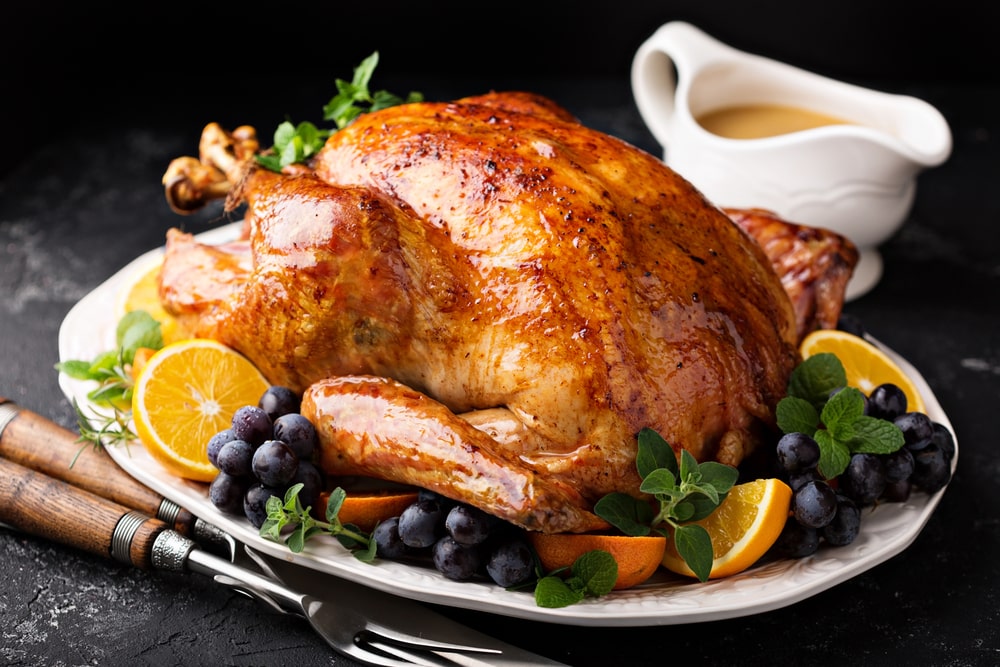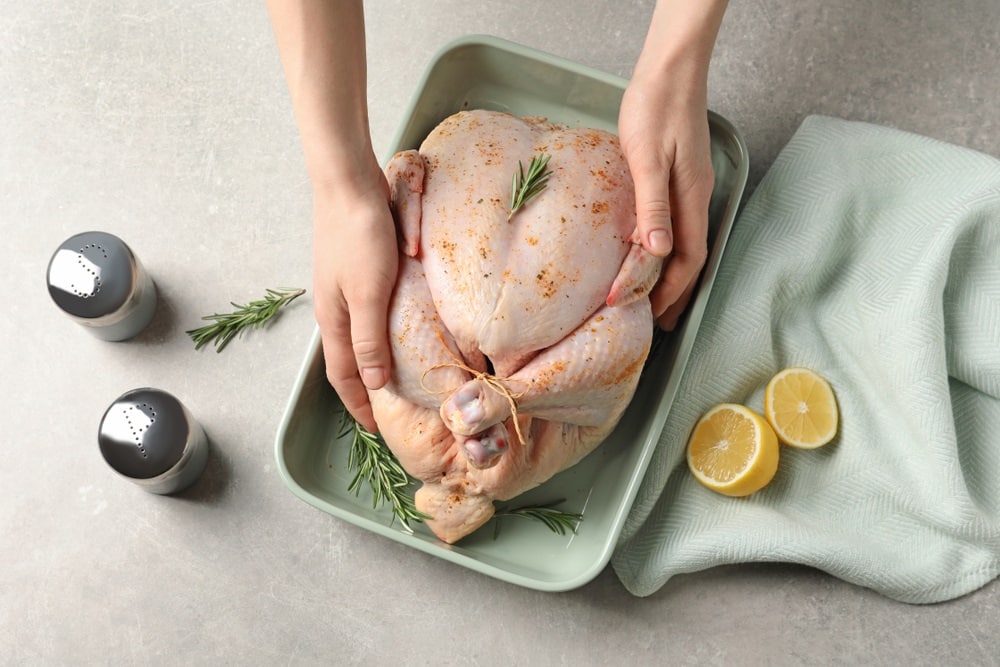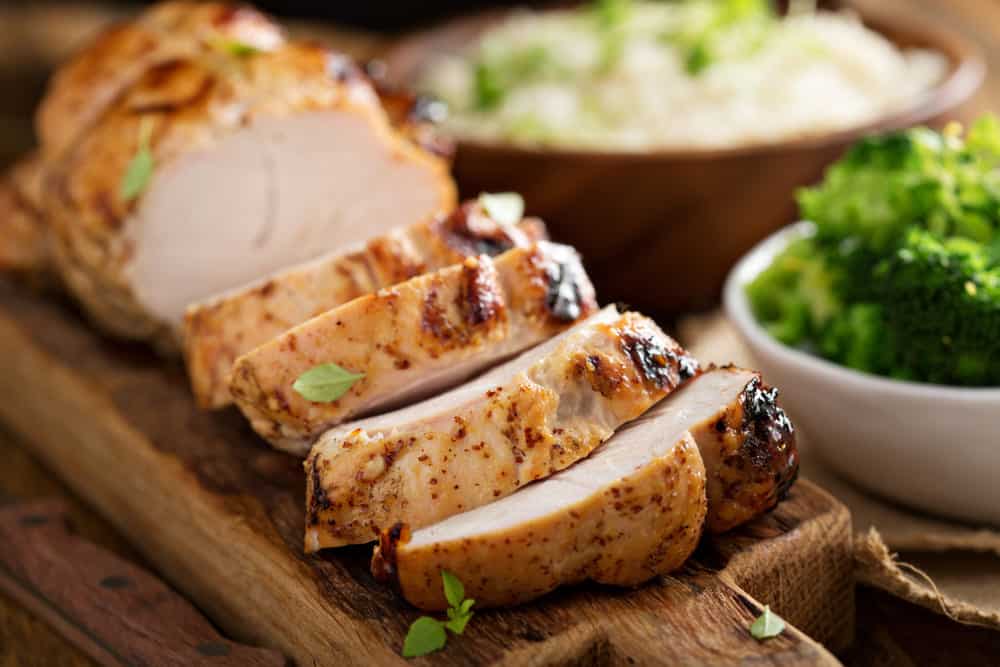
Turkey is enjoyed in many homes in the US over Thanksgiving and the UK over the Christmas season. If you have ever bought a whole turkey to roast, then you might have noticed a plastic or metal clip on its legs tying it together.
These clips are also sometimes used on other types of butchered poultry such as chickens or ducks. You may be wondering if you should remove it before cooking or if it is safe to leave it on.
We answer all your questions in this short article.
Why Is There Plastic On The Turkey Legs?
The plastic clip tying the turkey legs together is called a “hock lock”, “leg truss” or “oven-safe leg holder”.
Its purpose is to secure the legs, or hock, of a chicken or turkey together during processing and packing. It also holds the bird in a neat shape while cooking, preventing the legs from spreading open or falling off.
Different poultry suppliers use different types of hock trusses. Some are made of metal while others are made of heat-resistant nylon or plastic. This should give you a clue about whether or not it is safe to leave the plastic on during cooking.
Should I Remove The Plastic From The Turkey Legs?
Because these hock locks are made of heat-resistant materials, it is safe to leave them on during cooking at moderate temperatures.
A turkey is a large bird, and the best way to cook it is “low and slow” meaning that you would cook it at around 325 degrees Fahrenheit, covered with foil, for most of the cooking time.
During the last 45 minutes or so, you may increase the temperature to 350 degrees Fahrenheit to brown the skin of the bird. At this point, it is a good idea to remove the plastic.
How To Remove The Plastic Ties From Turkey Legs
You will need to cut the plastic with a pair of sharp kitchen scissors. Once loosened, pull gently to extract it from the skin and meat on the legs without damaging the turkey’s appearance.
What If I Want To Stuff My Turkey?
Some people like to go the traditional route and prepare some stuffing for their turkey before cooking it. In this case, you will need to remove the hock lock prior to cooking, stuff the bird, then re-truss it.
We recommend trussing it with kitchen string as it is tricky to slip the hock locks back on.
Do bear in mind that it takes quite a bit longer to cook a stuffed turkey as it is essential to cook the stuffing all the way through to prevent contamination. Many modern cooks prefer to cook the stuffing separately.
Reasons To Remove A Hock Lock Before Cooking
- If you want to stuff the bird, as outlined above.
- If the bird contains a packet with the giblets inside. This must be removed before cooking so to get it out, you will need to remove the hock lock. That said, most poultry producers will not put hock locks on a bird with the giblets still inside. Read the packaging to check.
- If you want the bird to cook faster. Trussing the legs means that the leg joints are pushed together and take longer to cook through so if you are in a hurry, you should remove the ties. Also, the longer time it takes to cook a trussed bird can result in the breast meat drying out.
- If you are deep frying or barbequing the turkey. While the plastic is oven safe at low temperatures, it will not withstand the high temperatures present in hot oil or a barbeque.
- If you are health conscious and don’t want any form of heated plastic on your food.
- If you want to properly rinse your turkey, inside and out, before cooking it.
Our Recommendation
We suggest that before cooking and stuffing your bird, you remove the plastic clip with kitchen scissors. Discard it. Rinse the turkey under cold running water and pat it dry. Stuff it if you desire.
Now, to preserve the bird’s neat appearance and to prevent the stuffing from falling out, tie the ends of the legs together with kitchen string.
Place the turkey in a suitable roasting dish, season it, and cover it with foil.
Roast it in a preheated oven at 325 degrees Fahrenheit for 40 minutes per kilogram/20 minutes per pound plus an extra 70 minutes for a 2-4 kg bird, and an extra 90 minutes for a 4-10 kg bird. In other words, an average bird will take about 4 hours to cook.
Before carving, remove the string and enjoy!
To Conclude
Although the tie on the turkey legs is manufactured from plastic, we are told that it is safe to leave it on when cooking under normal conditions. The plastic it is made of is certified to be heat safe. Leaving it on results in a neat appearance at the table.
However, removing the tie will help the bird cook more evenly and quickly. It’s your call. Now that you understand what they are and what they’re for, we’ll leave it up to you to decide if you should remove the plastic hock locks from the turkey legs.


